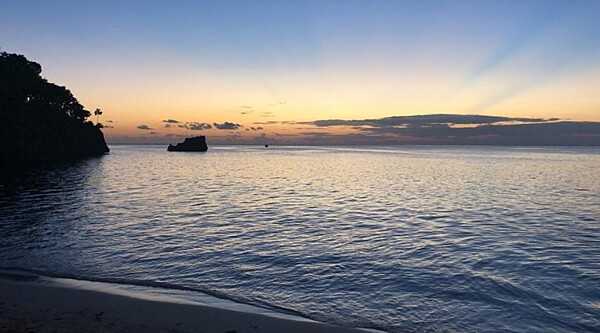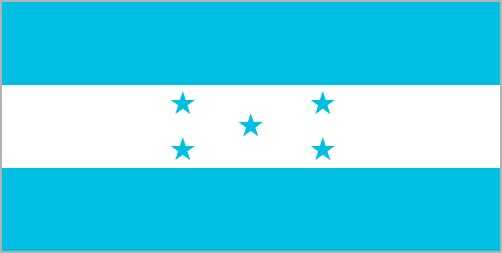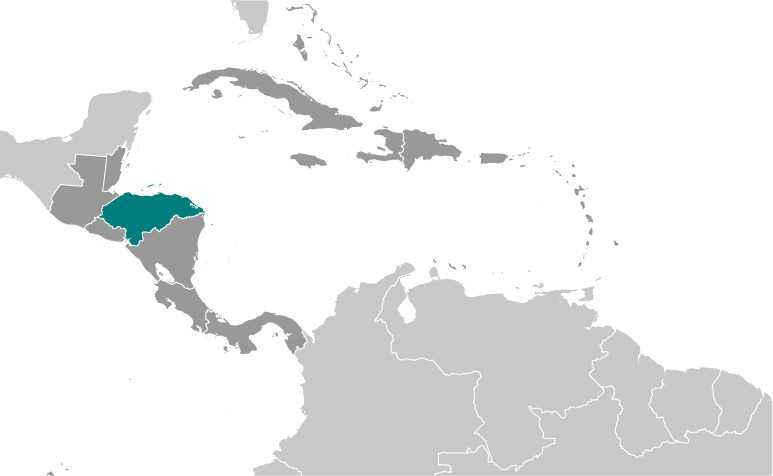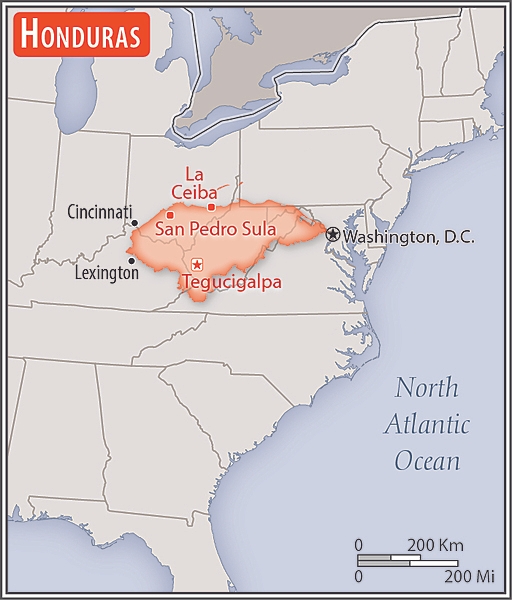Introduction
Background
Once part of Spain's vast empire in the New World, Honduras became an independent nation in 1821. After two and a half decades of mostly military rule, a freely elected civilian government came to power in 1982. During the 1980s, Honduras proved a haven for anti-Sandinista contras fighting the Marxist Nicaraguan Government and an ally to Salvadoran Government forces fighting leftist guerrillas. Hurricane Mitch devastated the country in 1998, killing about 5,600 people and causing approximately $2 billion in damage. Since then, the economy has slowly rebounded, despite COVID-19 and severe storm-related setbacks in 2020 and 2021.
Visit the Definitions and Notes page to view a description of each topic.
Geography
Location
Central America, bordering the Caribbean Sea, between Guatemala and Nicaragua and bordering the Gulf of Fonseca (North Pacific Ocean), between El Salvador and Nicaragua
Geographic coordinates
15 00 N, 86 30 W
Map references
Central America and the Caribbean
Land boundaries
total: 1,575 km
border countries (3): Guatemala 244 km; El Salvador 391 km; Nicaragua 940 km
Coastline
823 km (Caribbean Sea 669 km, Gulf of Fonseca 163 km)
Maritime claims
territorial sea: 12 nm
contiguous zone: 24 nm
exclusive economic zone: 200 nm
continental shelf: natural extension of territory or to 200 nm
Climate
subtropical in lowlands, temperate in mountains
Terrain
mostly mountains in interior, narrow coastal plains
Elevation
highest point: Cerro Las Minas 2,870 m
lowest point: Caribbean Sea 0 m
mean elevation: 684 m
Natural resources
timber, gold, silver, copper, lead, zinc, iron ore, antimony, coal, fish, hydropower
Land use
agricultural land: 28.8% (2018 est.)
arable land: 9.1% (2018 est.)
permanent crops: 4% (2018 est.)
permanent pasture: 15.7% (2018 est.)
forest: 45.3% (2018 est.)
other: 25.9% (2018 est.)
Irrigated land
900 sq km (2012)
Major lakes (area sq km)
salt water lake(s): Laguna de Caratasca - 1,110 sq km
Population distribution
most residents live in the mountainous western half of the country; unlike other Central American nations, Honduras is the only one with an urban population that is distributed between two large centers - the capital of Tegucigalpa and the city of San Pedro Sula; the Rio Ulua valley in the north is the only densely populated lowland area
Natural hazards
frequent, but generally mild, earthquakes; extremely susceptible to damaging hurricanes and floods along the Caribbean coast
Geography - note
has only a short Pacific coast but a long Caribbean shoreline, including the virtually uninhabited eastern Mosquito Coast
People and Society
Population
total: 9,529,188
male: 4,591,247
female: 4,937,941 (2024 est.)
comparison rankings: female 96; male 97; total 96
Nationality
noun: Honduran(s)
adjective: Honduran
Ethnic groups
Mestizo (mixed Indigenous and European) 90%, Indigenous 7%, African descent 2%, White 1%
Languages
Spanish (official), Amerindian dialects
major-language sample(s):
La Libreta Informativa del Mundo, la fuente indispensable de información básica. (Spanish)
The World Factbook, the indispensable source for basic information.
Religions
Evangelical 55%, Roman Catholic 33.4%, none 10.1%, unspecified 1.5% (2023 est.)
Demographic profile
Honduras is one of the poorest countries in Latin America and has one of the world's highest murder rates. More than half of the population lives in poverty and per capita income is one of the lowest in the region. Poverty rates are higher among rural and indigenous people and in the south, west, and along the eastern border than in the north and central areas where most of Honduras' industries and infrastructure are concentrated. The increased productivity needed to break Honduras' persistent high poverty rate depends, in part, on further improvements in educational attainment. Although primary-school enrollment is near 100%, educational quality is poor, the drop-out rate and grade repetition remain high, and teacher and school accountability is low.
Honduras' population growth rate has slowed since the 1990s and is now 1.2% annually with a birth rate that averages 2.1 children per woman and more among rural, indigenous, and poor women. Honduras' young adult population - ages 15 to 29 - is projected to continue growing rapidly for the next three decades and then stabilize or slowly shrink. Population growth and limited job prospects outside of agriculture will continue to drive emigration. Remittances represent about a fifth of GDP.
Age structure
0-14 years: 28.7% (male 1,378,026/female 1,353,238)
15-64 years: 65.7% (male 2,980,393/female 3,282,159)
65 years and over: 5.6% (2024 est.) (male 232,828/female 302,544)
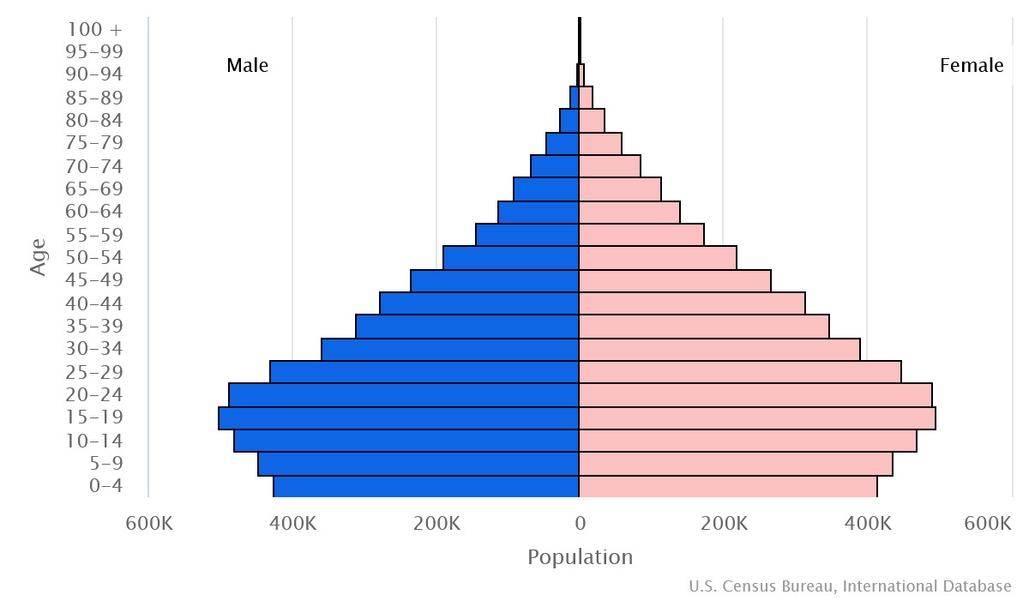
Dependency ratios
total dependency ratio: 53.3
youth dependency ratio: 46.9
elderly dependency ratio: 6.4
potential support ratio: 15.5 (2021 est.)
Median age
total: 25.7 years (2024 est.)
male: 24.8 years
female: 26.6 years
comparison ranking: total 168
Population distribution
most residents live in the mountainous western half of the country; unlike other Central American nations, Honduras is the only one with an urban population that is distributed between two large centers - the capital of Tegucigalpa and the city of San Pedro Sula; the Rio Ulua valley in the north is the only densely populated lowland area
Urbanization
urban population: 60.2% of total population (2023)
rate of urbanization: 2.48% annual rate of change (2020-25 est.)
Major urban areas - population
1.568 million TEGUCIGALPA (capital), 982,000 San Pedro Sula (2023)
Sex ratio
at birth: 1.03 male(s)/female
0-14 years: 1.02 male(s)/female
15-64 years: 0.91 male(s)/female
65 years and over: 0.77 male(s)/female
total population: 0.93 male(s)/female (2024 est.)
Mother's mean age at first birth
20.3 years (2011/12 est.)
note: data represents median age a first birth among women 25-49
Infant mortality rate
total: 15.4 deaths/1,000 live births (2024 est.)
male: 17.5 deaths/1,000 live births
female: 13.2 deaths/1,000 live births
comparison ranking: total 90
Life expectancy at birth
total population: 73.1 years (2024 est.)
male: 69.6 years
female: 76.8 years
comparison ranking: total population 152
Gross reproduction rate
1.15 (2024 est.)
Contraceptive prevalence rate
69.4% (2019)
Drinking water source
improved: urban: 100% of population
rural: 90.7% of population
total: 96.1% of population
unimproved: urban: 0% of population
rural: 9.3% of population
total: 3.9% of population (2020 est.)
Current health expenditure
9% of GDP (2020)
Physician density
0.5 physicians/1,000 population (2020)
Hospital bed density
0.6 beds/1,000 population (2017)
Sanitation facility access
improved: urban: 96.7% of population
rural: 87.9% of population
total: 93% of population
unimproved: urban: 3.3% of population
rural: 12.1% of population
total: 7% of population (2020 est.)
Major infectious diseases
degree of risk: high (2023)
food or waterborne diseases: bacterial diarrhea, hepatitis A, and typhoid fever
vectorborne diseases: dengue fever
Alcohol consumption per capita
total: 2.73 liters of pure alcohol (2019 est.)
beer: 1.6 liters of pure alcohol (2019 est.)
wine: 0.04 liters of pure alcohol (2019 est.)
spirits: 1.09 liters of pure alcohol (2019 est.)
other alcohols: 0 liters of pure alcohol (2019 est.)
comparison ranking: total 119
Currently married women (ages 15-49)
53.5% (2023 est.)
Child marriage
women married by age 15: 9.2%
women married by age 18: 34%
men married by age 18: 10% (2019 est.)
Literacy
definition: age 15 and over can read and write
total population: 88.5%
male: 88.2%
female: 88.7% (2019)
School life expectancy (primary to tertiary education)
total: 10 years
male: 10 years
female: 11 years (2019)
Environment
Environment - current issues
urban population expanding; deforestation results from logging and the clearing of land for agricultural purposes; further land degradation and soil erosion hastened by uncontrolled development and improper land use practices such as farming of marginal lands; mining activities polluting Lago de Yojoa (the country's largest source of fresh water), as well as several rivers and streams, with heavy metals
Environment - international agreements
party to: Biodiversity, Climate Change, Climate Change-Kyoto Protocol, Climate Change-Paris Agreement, Comprehensive Nuclear Test Ban, Desertification, Endangered Species, Environmental Modification, Hazardous Wastes, Law of the Sea, Marine Dumping-London Convention, Nuclear Test Ban, Ozone Layer Protection, Ship Pollution, Tropical Timber 2006, Wetlands
signed, but not ratified: none of the selected agreements
Climate
subtropical in lowlands, temperate in mountains
Land use
agricultural land: 28.8% (2018 est.)
arable land: 9.1% (2018 est.)
permanent crops: 4% (2018 est.)
permanent pasture: 15.7% (2018 est.)
forest: 45.3% (2018 est.)
other: 25.9% (2018 est.)
Urbanization
urban population: 60.2% of total population (2023)
rate of urbanization: 2.48% annual rate of change (2020-25 est.)
Air pollutants
particulate matter emissions: 18.93 micrograms per cubic meter (2019 est.)
carbon dioxide emissions: 9.81 megatons (2016 est.)
methane emissions: 7.72 megatons (2020 est.)
Waste and recycling
municipal solid waste generated annually: 2,162,028 tons (2016 est.)
Major lakes (area sq km)
salt water lake(s): Laguna de Caratasca - 1,110 sq km
Total water withdrawal
municipal: 320 million cubic meters (2020 est.)
industrial: 111 million cubic meters (2020 est.)
agricultural: 1.18 billion cubic meters (2020 est.)
Total renewable water resources
92.16 billion cubic meters (2020 est.)
Government
Country name
conventional long form: Republic of Honduras
conventional short form: Honduras
local long form: República de Honduras
local short form: Honduras
etymology: the name means "depths" in Spanish and refers to the deep anchorage in the northern Bay of Trujillo
Government type
presidential republic
Capital
name: Tegucigalpa; note - article eight of the Honduran constitution states that the twin cities of Tegucigalpa and Comayaguela, jointly, constitute the capital of the Republic of Honduras; however, virtually all governmental institutions are on the Tegucigalpa side, which in practical terms makes Tegucigalpa the capital
geographic coordinates: 14 06 N, 87 13 W
time difference: UTC-6 (1 hour behind Washington, DC during Standard Time)
etymology: while most sources agree that Tegucigalpa is of Nahuatl derivation, there is no consensus on its original meaning
Administrative divisions
18 departments (departamentos, singular - departamento); Atlantida, Choluteca, Colon, Comayagua, Copan, Cortes, El Paraiso, Francisco Morazan, Gracias a Dios, Intibuca, Islas de la Bahia, La Paz, Lempira, Ocotepeque, Olancho, Santa Barbara, Valle, Yoro
Independence
15 September 1821 (from Spain)
National holiday
Independence Day, 15 September (1821)
Constitution
history: several previous; latest approved 11 January 1982, effective 20 January 1982
amendments: proposed by the National Congress with at least two-thirds majority vote of the membership; passage requires at least two-thirds majority vote of Congress in its next annual session; constitutional articles, such as the form of government, national sovereignty, the presidential term, and the procedure for amending the constitution, cannot be amended; amended several times, last in 2021
Legal system
civil law system
International law organization participation
accepts compulsory ICJ jurisdiction with reservations; accepts ICCt jurisdiction
Citizenship
citizenship by birth: yes
citizenship by descent only: yes
dual citizenship recognized: yes
residency requirement for naturalization: 1 to 3 years
Suffrage
18 years of age; universal and compulsory
Executive branch
chief of state: President Iris Xiomara CASTRO de Zelaya (since 27 January 2022)
head of government: President Iris Xiomara CASTRO de Zelaya (since 27 January 2022)
cabinet: Cabinet appointed by president
elections/appointments: president directly elected by simple majority popular vote for a 4-year term; election last held on 28 November 2021 (next to be held on 30 November 2025); note - in 2015, the Constitutional Chamber of the Honduran Supreme Court struck down the constitutional provisions on presidential term limits
election results:
2021: Iris Xiomara CASTRO de Zelaya elected president; percent of vote - Iris Xiomara CASTRO de Zelaya (LIBRE) 51.1%, Nasry Juan ASFURA Zablah (PNH) 36.9%, Yani Benjamin ROSENTHAL Hidalgo (PL) 10%, other 2%
2017: Juan Orlando HERNANDEZ Alvarado reelected president; percent of vote - Juan Orlando HERNANDEZ Alvarado (PNH) 43%, Salvador NASRALLA (Alianza de Oposicion contra la Dictadura) 41.4%, Luis Orlando ZELAYA Medrano (PL) 14.7%, other 0.9%
note: the president is both chief of state and head of government
Legislative branch
description: unicameral National Congress or Congreso Nacional (128 seats; members directly elected in 18 multi-seat constituencies by closed party-list proportional representation vote; members serve 4-year terms)
elections: last held on 28 November 2021 (next to be held on 30 November 2025)
election results: percent of vote by party - LIBRE 39.8%, PNH 31.3%, PL 16.4%, PSH 10.9%, DC 0.8%, PAC 0.8%; seats by party - LIBRE 51, PNH 40, PL 21, PSH 14, DC 1, PAC 1; composition - men 93, women 35, percentage women 27.3%
note: seats by party as of 1 May 2022 - LIBRE 50, PNH 44, PL 22, PSH 10, DC 1, PAC 1
Judicial branch
highest court(s): Supreme Court of Justice or Corte Suprema de Justicia (15 principal judges, including the court president, and 6 alternates; court organized into civil, criminal, constitutional, and labor chambers); note - the court has both judicial and constitutional jurisdiction
judge selection and term of office: court president elected by his peers; judges elected by the National Congress from candidates proposed by the Nominating Board, a diverse 7-member group of judicial officials and other government and non-government officials nominated by each of their organizations; judges elected by Congress for renewable, 7-year terms
subordinate courts: courts of appeal; courts of first instance; justices of the peace
Political parties and leaders
Anti-Corruption Party or PAC [Marlene ALVARENGA]
Christian Democratic Party or DC [Carlos PORTILLO]
Democratic Liberation of Honduras or Liderh [Lempira VIANA]
Democratic Unification Party or UD [Alfonso DIAZ Narvaez]
The Front or El Frente [Kelin PEREZ]
Honduran Patriotic Alliance or AP [Romeo VASQUEZ Velasquez]
Innovation and Unity Party or PINU [Guillermo VALLE]
Liberal Party or PL [Yani Benjamin ROSENTHAL Hidalgo]
Liberty and Refoundation Party or LIBRE [Jose Manuel ZELAYA Rosales]
National Party of Honduras or PNH [Juan Nasry ASFURA]
New Route or NR [Esdras Amado LOPEZ]
Opposition Alliance against the Dictatorship or Alianza de Oposicion contra la Dictadura [Salvador NASRALLA] (electoral coalition)
Savior Party of Honduras or PSH [Salvador Alejandro Cesar NASRALLA Salum]
Vamos or Let’s Go [Jose COTO]
We Are All Honduras (Todos Somos Honduras) or TSH [Marlon Oniel ESCOTO Valerio]
International organization participation
ACS, BCIE, CACM, CD, CELAC, EITI (candidate country), FAO, G-11, G-77, IADB, IAEA, IBRD, ICAO, ICCt, ICRM, IDA, IFAD, IFC, IFRCS, ILO, IMF, IMO, Interpol, IOC (suspended), IOM, IPU, ISO (subscriber), ITSO, ITU, ITUC (NGOs), LAES, LAIA (observer), MIGA, MINURSO, MINUSTAH, NAM, OAS, OPANAL, OPCW, Pacific Alliance (observer), PCA, Petrocaribe, SICA, UN, UNCTAD, UNHRC, UNESCO, UNIDO, Union Latina, UNWTO, UPU, WCO (suspended), WFTU (NGOs), WHO, WIPO, WMO, WTO
Diplomatic representation in the US
chief of mission: Ambassador Javier Efrain BU SOTO (since 12 December 2022)
chancery: 1220 19th Street NW, Suite #320, Washington, DC 20036
telephone: [1] (202) 966-7702
FAX: [1] (202) 966-9751
email address and website:
info@wadchn.com
https://hondurasembusa.org/
consulate(s) general: Atlanta, Boston, Charlotte (NC), Chicago, Dallas, Houston, Los Angeles, McAllen (TX), Miami, New Orleans, New York, San Francisco, Seattle
Diplomatic representation from the US
chief of mission: Ambassador Laura F. DOGU (since 12 April 2022)
embassy: Avenida La Paz, Tegucigalpa M.D.C.
mailing address: 3480 Tegucigalpa Place, Washington DC 20521-3480
telephone: [504] 2236-9320,
FAX: [504] 2236-9037
email address and website:
usahonduras@state.gov
https://hn.usembassy.gov/
Flag description
three equal horizontal bands of cerulean blue (top), white, and cerulean blue, with five cerulean, five-pointed stars arranged in an X pattern centered in the white band; the stars represent the members of the former Federal Republic of Central America: Costa Rica, El Salvador, Guatemala, Honduras, and Nicaragua; the blue bands symbolize the Pacific Ocean and the Caribbean Sea; the white band represents the land between the two bodies of water and the peace and prosperity of its people
note: similar to the flag of El Salvador, which features a round emblem encircled by the words REPUBLICA DE EL SALVADOR EN LA AMERICA CENTRAL centered in the white band; also similar to the flag of Nicaragua, which features a triangle encircled by the words REPUBLICA DE NICARAGUA on top and AMERICA CENTRAL on the bottom, centered in the white band
National symbol(s)
scarlet macaw, white-tailed deer; national colors: blue, white
National anthem
name: "Himno Nacional de Honduras" (National Anthem of Honduras)
lyrics/music: Augusto Constancio COELLO/Carlos HARTLING
note: adopted 1915; the anthem's seven verses chronicle Honduran history; on official occasions, only the chorus and last verse are sung
National heritage
total World Heritage Sites: 2 (1 cultural, 1 natural)
selected World Heritage Site locales: Maya Site of Copan (c); Río Plátano Biosphere Reserve (n)
Economy
Economic overview
second-fastest-growing Central American economy; COVID-19 and two hurricanes crippled activity; high poverty and inequality; declining-but-still-high violent crime disruption; systemic corruption; coffee and banana exporter; enormous remittances
Real GDP (purchasing power parity)
$68.854 billion (2023 est.)
$66.473 billion (2022 est.)
$63.828 billion (2021 est.)
note: data in 2021 dollars
comparison ranking: 110
Real GDP growth rate
3.58% (2023 est.)
4.14% (2022 est.)
12.57% (2021 est.)
note: annual GDP % growth based on constant local currency
comparison ranking: 89
Real GDP per capita
$6,500 (2023 est.)
$6,400 (2022 est.)
$6,200 (2021 est.)
note: data in 2021 dollars
comparison ranking: 165
GDP (official exchange rate)
$34.401 billion (2023 est.)
note: data in current dollars at official exchange rate
Inflation rate (consumer prices)
6.66% (2023 est.)
9.09% (2022 est.)
4.48% (2021 est.)
note: annual % change based on consumer prices
comparison ranking: 139
Credit ratings
Moody's rating: B1 (2017)
Standard & Poors rating: BB- (2017)
note: The year refers to the year in which the current credit rating was first obtained.
GDP - composition, by sector of origin
agriculture: 14.2% (2017 est.)
industry: 28.8% (2017 est.)
services: 57% (2017 est.)
comparison rankings: services 142; industry 86; agriculture 67
GDP - composition, by end use
household consumption: 77.7% (2017 est.)
government consumption: 13.8% (2017 est.)
investment in fixed capital: 23.1% (2017 est.)
investment in inventories: 0.7% (2017 est.)
exports of goods and services: 43.6% (2017 est.)
imports of goods and services: -58.9% (2017 est.)
Agricultural products
sugarcane, oil palm fruit, milk, maize, bananas, coffee, cantaloupes/melons, chicken, oranges, beans (2022)
note: top ten agricultural products based on tonnage
Industries
sugar processing, coffee, woven and knit apparel, wood products, cigars
Industrial production growth rate
-2.04% (2023 est.)
note: annual % change in industrial value added based on constant local currency
comparison ranking: 183
Labor force
4.676 million (2023 est.)
note: number of people ages 15 or older who are employed or seeking work
comparison ranking: 91
Unemployment rate
6.06% (2023 est.)
7.04% (2022 est.)
7.94% (2021 est.)
note: % of labor force seeking employment
comparison ranking: 127
Youth unemployment rate (ages 15-24)
total: 15.5% (2021 est.)
male: 11.4%
female: 24.6%
comparison ranking: total 112
Population below poverty line
48% (2019 est.)
note: % of population with income below national poverty line
Gini Index coefficient - distribution of family income
48.2 (2019 est.)
note: index (0-100) of income distribution; higher values represent greater inequality
comparison ranking: 16
Average household expenditures
on food: 31.9% of household expenditures (2021 est.)
on alcohol and tobacco: 4.9% of household expenditures (2021 est.)
Household income or consumption by percentage share
lowest 10%: 1.2% (2019 est.)
highest 10%: 34.6% (2019 est.)
note: % share of income accruing to lowest and highest 10% of population
Remittances
25.58% of GDP (2023 est.)
27% of GDP (2022 est.)
25.59% of GDP (2021 est.)
note: personal transfers and compensation between resident and non-resident individuals/households/entities
Budget
revenues: $6.476 billion (2019 est.)
expenditures: $6.454 billion (2019 est.)
Taxes and other revenues
15.07% (of GDP) (2020 est.)
note: central government tax revenue as a % of GDP
comparison ranking: 141
Current account balance
-$1.335 billion (2023 est.)
-$2.063 billion (2022 est.)
-$1.538 billion (2021 est.)
note: balance of payments - net trade and primary/secondary income in current dollars
comparison ranking: 146
Exports
$9.701 billion (2023 est.)
$9.403 billion (2022 est.)
$8.052 billion (2021 est.)
note: balance of payments - exports of goods and services in current dollars
comparison ranking: 116
Exports - partners
US 51%, Nicaragua 8%, El Salvador 8%, Guatemala 5%, Germany 4% (2022)
note: top five export partners based on percentage share of exports
Exports - commodities
garments, coffee, insulated wire, palm oil, bananas (2022)
note: top five export commodities based on value in dollars
Imports
$17.861 billion (2023 est.)
$17.943 billion (2022 est.)
$14.869 billion (2021 est.)
note: balance of payments - imports of goods and services in current dollars
comparison ranking: 101
Imports - partners
US 47%, Guatemala 10%, China 10%, El Salvador 7%, Mexico 4% (2022)
note: top five import partners based on percentage share of imports
Imports - commodities
refined petroleum, cotton yarn, garments, synthetic fibers, plastic products (2022)
note: top five import commodities based on value in dollars
Reserves of foreign exchange and gold
$7.543 billion (2023 est.)
$8.41 billion (2022 est.)
$8.667 billion (2021 est.)
note: holdings of gold (year-end prices)/foreign exchange/special drawing rights in current dollars
comparison ranking: 95
Exchange rates
lempiras (HNL) per US dollar -
Exchange rates:
24.602 (2023 est.)
24.486 (2022 est.)
24.017 (2021 est.)
24.582 (2020 est.)
24.509 (2019 est.)
Energy
Electricity access
electrification - total population: 94.4% (2022 est.)
electrification - urban areas: 100%
electrification - rural areas: 86.8%
Electricity
installed generating capacity: 3.195 million kW (2022 est.)
consumption: 8.789 billion kWh (2022 est.)
exports: 3 million kWh (2022 est.)
imports: 212.156 million kWh (2022 est.)
transmission/distribution losses: 3.424 billion kWh (2022 est.)
comparison rankings: transmission/distribution losses 147; imports 105; exports 99; consumption 111; installed generating capacity 107
Electricity generation sources
fossil fuels: 36.9% of total installed capacity (2022 est.)
solar: 9.9% of total installed capacity (2022 est.)
wind: 6.5% of total installed capacity (2022 est.)
hydroelectricity: 33.3% of total installed capacity (2022 est.)
geothermal: 3% of total installed capacity (2022 est.)
biomass and waste: 10.4% of total installed capacity (2022 est.)
Coal
consumption: 190,000 metric tons (2022 est.)
imports: 190,000 metric tons (2022 est.)
Petroleum
total petroleum production: 20 bbl/day (2023 est.)
refined petroleum consumption: 67,000 bbl/day (2022 est.)
Carbon dioxide emissions
9.428 million metric tonnes of CO2 (2022 est.)
from coal and metallurgical coke: 429,000 metric tonnes of CO2 (2022 est.)
from petroleum and other liquids: 8.999 million metric tonnes of CO2 (2022 est.)
comparison ranking: total emissions 107
Communications
Telephones - fixed lines
total subscriptions: 414,000 (2022 est.)
subscriptions per 100 inhabitants: 4 (2022 est.)
comparison ranking: total subscriptions 100
Telephones - mobile cellular
total subscriptions: 7.937 million (2022 est.)
subscriptions per 100 inhabitants: 76 (2022 est.)
comparison ranking: total subscriptions 102
Telecommunication systems
general assessment:
Honduras is among the poorest countries in Central America and has long been plagued by an unstable political framework which has rendered telecom sector reform difficult; this has created real difficulties for telcos as well as consumers; fixed-line teledensity, at only 4.9%, is significantly lower than the Latin American and Caribbean average; poor fixed-line infrastructure has been exacerbated by low investment and topographical difficulties which have made investment in rural areas unattractive or uneconomical; the internet has been slow to develop; DSL and cable modem technologies are available but are relatively expensive, while higher speed services are largely restricted to the major urban centers; the demand for broadband is steadily increasing and there has been some investment in network upgrades to fiber-based infrastructure
(2022)
domestic: fixed-line teledensity of 5 per 100; mobile-cellular subscribership is roughly 74 per 100 persons (2021)
international: country code - 504; landing points for both the ARCOS and the MAYA-1 fiber-optic submarine cable systems that together provide connectivity to South and Central America, parts of the Caribbean, and the US; satellite earth stations - 2 Intelsat (Atlantic Ocean); connected to Central American Microwave System (2019)
Broadcast media
multiple privately owned terrestrial TV networks, supplemented by multiple cable TV networks; Radio Honduras is the lone government-owned radio network; roughly 300 privately owned radio stations (2019)
Internet users
total: 4.8 million (2021 est.)
percent of population: 48% (2021 est.)
comparison ranking: total 99
Broadband - fixed subscriptions
total: 396,916 (2020)
subscriptions per 100 inhabitants: 4 (2020 est.)
comparison ranking: total 97
Transportation
National air transport system
number of registered air carriers: 4 (2020)
inventory of registered aircraft operated by air carriers: 26
annual passenger traffic on registered air carriers: 251,149 (2018)
annual freight traffic on registered air carriers: 450,000 (2018) mt-km
Heliports
6 (2024)
Railways
total: 699 km (2014)
narrow gauge: 164 km (2014) 1.067-m gauge
115 km 1.057-mm gauge
420 km 0.914-mm gauge
comparison ranking: total 100
Roadways
total: 14,742 km
paved: 3,367 km
unpaved: 11,375 km (2012) (1,543 km summer only)
note: an additional 8,951 km of non-official roads used by the coffee industry
comparison ranking: total 126
Merchant marine
total: 489 (2023)
by type: general cargo 233, oil tanker 82, other 174
comparison ranking: total 43
Ports
total ports: 8 (2024)
large: 0
medium: 0
small: 1
very small: 7
ports with oil terminals: 3
key ports: Coxen Hole, La Ceiba, Puerto Castilla, Puerto Cortes, Puerto de Hencan, Puerto Este, Tela, Trujillo
Military and Security
Military and security forces
Honduran Armed Forces (Fuerzas Armadas de Honduras, FFAA): Army (Ejercito), Honduran Naval Forces (Fuerzas Naval Hondurena, FNH; includes marines), Honduran Air Force (Fuerza Aerea Hondurena, FAH), Honduran Military Police of Public Order (Policía Militar del Orden Público or PMOP) (2024)
note 1: the National Police of Honduras (Policía Nacional de Honduras, PNH) are under the Secretariat of Security and responsible for internal security; some larger cities have police forces that operate independently of the national police and report to municipal authorities
note 2: the PMOP supports the PNH against narcotics trafficking and organized crime; it is subordinate to the Secretariat of Defense/FFAA, but conducts operations sanctioned by civilian security officials as well as by military leaders
note 3: the National Interinstitutional Security Force is an interagency command that coordinates the overlapping responsibilities of the HNP, PMOP, and other security organizations such as the National Intelligence Directorate and the Public Ministry (public prosecutor), but exercises coordination, command, and control responsibilities only during interagency operations involving those forces
Military expenditures
1.5% of GDP (2023 est.)
1.4% of GDP (2022 est.)
1.5% of GDP (2021 est.)
1.6% of GDP (2020 est.)
1.6% of GDP (2019 est.)
comparison ranking: 92
Military and security service personnel strengths
approximately 16,000 active personnel (7,500 Army; 1,500 Navy, including about 1,000 marines; 2,000 Air Force; 5,000 Military Police of Public Order); approximately 18,000 National Police (2023)
Military equipment inventories and acquisitions
the FFAA's inventory is comprised of mostly older imported equipment from Israel, the UK, and the US; in recent years, it has received limited amounts of military equipment from several countries, including Colombia and Israel (2023)
Military service age and obligation
18-22 years of age for voluntary military service for men and women; 24-36 month service obligation; no conscription (2024)
note: as of 2023, women made up about 9% of the active duty military
Military - note
the Honduran Armed Forces (FFAA) are responsible for maintaining the country’s territory, defending its sovereignty, providing emergency/humanitarian assistance, and supporting the National Police (PNH); the FFAA’s primary focus is internal and border security, and since 2011 a considerable portion of it has been deployed to support the PNH in combating narcotics trafficking and organized crime; military support to domestic security included the creation of the Military Police of Public Order (PMOP) in 2013 to provide security in areas controlled by street gangs to combat crime and make arrests; the PMOP also has sent personnel to reinforce security operations along the country’s border as part of a tri-national security task force with El Salvador and Guatemala; the FFAA has received military equipment, training, humanitarian, and technical assistance from the US military; the US military maintains a joint service task force co-located with the FFAA at Soto Cano Air Base (2024)
Transnational Issues
Refugees and internally displaced persons
IDPs: 247,000 (violence, extortion, threats, forced recruitment by urban gangs between 2004 and 2018) (2023)
Illicit drugs
transshipment point for cocaine destined for the United States and precursor chemicals used to produce illicit drugs; some small-scale coca cultivation
